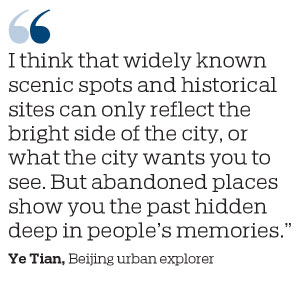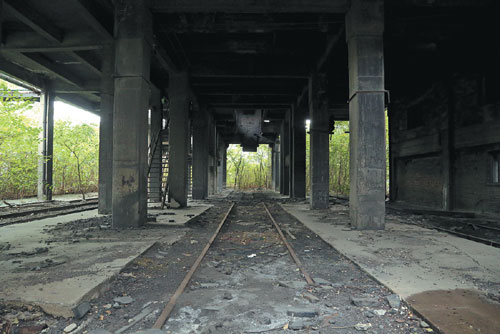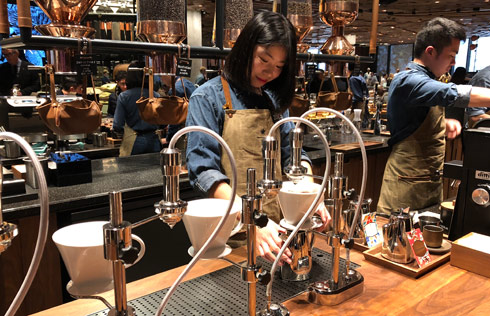URBAN EXPLORERS WIDEN THEIR HORIZONS
Knowledge enhanced by trips to abandoned sites
With a bag on his back and his hands in his pockets, Ye Tian sneaked around the fence, trying to find an entrance to the abandoned coking works without being noticed.
"There is a dog!" he said. "I'm not afraid of the gatekeeper - at least I can negotiate with him. But a dog? Forget it. I'll find another way."
While planning his special visit to the Beijing site, the 25-year-old did some research, but still failed to locate the entrance.
Ye is among the thousands who are interested in "taking adventures", which they call urban exploration, or "urbex".
The aim is to explore structures - usually abandoned ruins or "hidden components of the man-made environment".
Venturing into abandoned structures is one of the most common examples of urban exploration. Although targets vary from one country to another, high-profile abandonments usually include amusement parks, factories, power plants, missile silos, fallout shelters, hospitals, asylums, schools and houses.
Urban explorers are interested in visiting such sites, as they can discover "other parts of a city" and get to understand its history from a different angle.
Ye, who worked as an intern for a German company in Beijing for six months, said he enjoyed the contrast between the city's two sides - modern and crowded, compared with old-fashioned and silent - and wanted to learn more about the capital during his short stay.
Standing on a small platform outside the fence to the site, Ye looked at the workshops and wondered what each building had been used for.
"I think that widely known scenic spots and historical sites can only reflect the bright side of the city, or what the city wants you to see," he said. "But abandoned places show you the past hidden deep in people's memories."
Ye said he is also planning an urban adventure to the Fusuijing Building in Xicheng district, one of three community buildings established in Beijing in the 1950s.
There were no individual kitchens for each household, but a large dining hall that could accommodate 500 people. There were also kindergartens, barbershops, kiosks, showers and a range of other facilities.
"The building was a result of the Great Leap Forward, and was a strong feature of that period. That is something you can't learn from a textbook," Ye said.
The Great Leap Forward (1958-60) was a campaign designed to promote the rapid development of China's economy and industry.
"The building has not been fully abandoned, because there are still some residents reluctant to move out. If possible, I really want to know what it feels like to live in such a place," Ye said.
According to urban explorer Pan Ran, an abandoned building or the period of time in which it was vacated will evoke memories in those who lived and worked in it.
Pan, who is in her early 30s and lives and works in Canada, started her urban explorations in the summer of 2015.
"It was an abandoned public facility - a playground near Sauble Beach in northern Ontario, Canada. Although it had only been abandoned for two or three years, weeds had engulfed the slides, kart lanes and swimming pools," she said.
"I still remember there was a smile painted on the window of the ticket office. It might have been done to convey a feeling of warmth and happiness, but it turned out to be particularly ironic at this dilapidated site."
Pan said she can never forget first glimpsing the site, especially seeing its "weird and peculiar beauty under the shadows".
Since then, the "freshness and excitement" brought by urban exploration as well as the attraction of such doomsday-like scenes have pushed her to discover more, and in the past four years, she has visited at least 500 ruins across Asia and North America.
The more Pan explored, the more she wanted to know the stories behind the sites. In 2016, she began to archive each abandoned venue she visited by doing a large amount of research in an attempt to profile everyone who was closely connected to such places.
Last year, she started to take photos of some houses she described as "time capsules", where the owners suddenly left but all the items remained in place.
"It's really hard to find more information on such houses, but they always surprise me," she said. "There are diaries and letters recording the owners' lives. And one time, I found a whole box of 8-millimeter videotapes of a family."
Pan said she was unable to watch the tapes at the site, as the power supply had been cut. She did not bring them away with her either, as there is "a very important rule of urbex that you can't remove any 'souvenirs' from a site".
One of her most memorable experiences came in late autumn 2017 when she and her companions drove to an abandoned airport in Virginia, United States.
On the way, she saw 43 busts of US presidents from George Washington to George W. Bush, each of them 6 meters high.
"They were like ghosts standing by the highway, silently watching every passing vehicle. Most of the statues had been mottled by the sun and rain, and were peeling like skin, leaving every president with gullies like tear strains."
But not all urban explorations are as simple and easy as this one, and Pan conceded that such missions can be quite dangerous.
In a post on the social networking service Douban by a group interested in exploring ruins in Beijing, the group leader, who wanted to be identified by his username Kun Lan, said people should follow some safety rules while exploring.

"First, don't get caught by security officials, as exploring urban ruins is not aimed at testing your spying skills," he wrote. "Second, be aware of the safety situation at the site itself. Scout the route and carry out a risk assessment in advance. If the building has a risk of collapse, it is best to abandon the exploration."
The group now has more than 10,000 fans, and a new post appears almost every day, discussing the latest exploration experience. Such posts usually include a series of pictures and site descriptions.
Pan, the urban explorer in Canada, said: "You also have to assess the difficulty of getting in and out of a site. For example, if you can't find the entrance, if it is boarded up or cemented over, or it's too hard to get in, then you have to think twice."
She also suggested wearing sturdy boots and gloves as further protection while visiting sites, adding, "A camera, lighting device, mask and a bottle of water are also in my backpack.
"Sometimes, you may also need some special training before you can go on an adventure," she said, adding that she prepared for more than six months before she explored the Baikonur Cosmodrome in Kazakhstan, home of the abandoned Buran space shuttle.
Ye, who visited the abandoned coking works in Beijing, said that although he was able to finally sneak in through another entrance, he was still asked to leave by a gatekeeper shortly after.
But he then managed to get into a newly built residential block, climbed to the top and took a picture of the factory ruins at sunset.
"I will come back another day," he said.
liuxuan@chinadaily.com.cn
|
The ruins of the Beijing Coking and Chemical Works are a target for urban explorers.Liu Xuan/china Daily |


(China Daily Global 10/23/2019 page1)



















